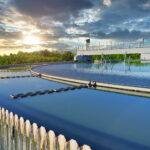The demand for more energy is growing at a rapid pace on a global scale, largely due to various international climate goals set in place to address growing populations and climate change impacts. Notably, the United Nations’ Sustainable Development Goal (UNSDG) 7 requires UN Member States to ensure access to affordable, reliable, sustainable and modern energy for all by 2030.
Different methods and solutions have been deployed to crack energy supply challenges throughout the past couple of decades. Renewable energy sources, such as wind power and solar energy, stand out as ways to reduce the impact fossil fuels have on global warming. Read more about offshore wind’s role in the fight from fossil fuels to renewable energy.
Even though wind has proven to be an important source of energy, there are still many more wind power opportunities waiting to be developed and deployed to reduce carbon footprints. This is where floating offshore wind power comes into the picture by providing power to households, transportation and industrial production.
The energy demand is growing faster and faster
UN predictions indicate that by 2050 almost 10 billion people will be living on earth. This population growth means that much more energy will have to be produced to meet the growing need for heat, light, transport and industrial production. According to the International Energy Agency’s (IEA) World Energy Outlook 2019, the world’s total energy needs will grow by 1.3% each year to 2040. With worldwide carbon reduction goals being significant, it is important to explore innovative ways of supporting sustainable energy production, such as floating wind farms, in the offshore wind industry.
Floating wind foundations vs. traditional offshore wind foundations
Traditionally, wind turbines typically stand on a construction that is firmly mounted in the seabed. This setup only works in water depths of about 50-80 meters or less. Since floating wind turbines don’t have large bottom-fixed foundations in direct contact with the seabed, the true potential of floating wind turbines is initially argued to be in deep waters. In other words, compared to traditional wind turbines, floating wind turbines expand the feasible area for offshore wind energy development, reduce visibility from shores, and can be placed in areas with more consistent and stronger wind speed. With high and steady wind characteristics, floating wind farms have the potential to reach higher production efficiency with a lower cost per MWh in contrast to traditional offshore wind turbines.
While it is predicted that floating wind foundation designs are likely to become more cost efficient, there are still many lessons to learn and more progress to be made until we see floating wind farms producing a significant amount of energy. The offshore wind industry is currently analysing and testing the possibilities of floating offshore wind development. This has resulted in floating wind turbine testing sites in Europe, Asia and a few locations in North America.
Floating wind farm opportunities are blowing across deep oceans
As the floating wind technology continues to develop, the industry is beginning to follow. While one could say that Europe is expected to be the key growth driver within the next 5-10 years, Asia is quickly recognising the potential of floating wind power. With ambitions of becoming an exporter of floating wind technology and services, the Asian governments are looking into leveraging the advantages of renewable floating offshore wind to address the climate crisis and at the same time meet their contribution to reaching the world’s carbon reduction goals. Since Asia is surrounded by deep oceans, countries in this area are potentially big markets for floating wind turbine deployment.
Taking the next step in floating wind development
It is without any doubt that there is a lot of potential in floating wind. Therefore, it is realistic to be optimistic in terms of the technology maturing to become an important part of the future renewable energy mix and help to reach global carbon reduction goals. It is, most likely, not a question of if it will happen, but more a question of when it will happen.
How should you proceed if you are in the offshore wind business? Talk to an industry expert to see how you can tackle uncertainties regarding logistical challenges, foundation construction, installation, operation and maintenance costs. Workability assessments are also useful to help you execute safe and efficient operations on offshore energy assets. Once these challenges are solved, there is potential that we will see production and implementation of floating wind turbines picking up to benefit our planet.








